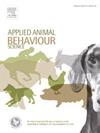Genetic and environmental parameters for birth weight and neonatal behaviour of Merino lambs in relation to cold stress
IF 2.2
2区 农林科学
Q1 AGRICULTURE, DAIRY & ANIMAL SCIENCE
引用次数: 0
Abstract
Lamb mortality remains a significant welfare and production issue, constraining ethical and sustainable sheep production. Lamb survival benefits from early suckling and colostrum intake, while it is impaired by inclement weather. The effect of cold exposure on neonatal behaviour and progress to suckling in lambs needs to be understood to curb lamb mortality. This study used historic data to establish the relationship of neonatal lamb behaviour with cold stress and derive genetic parameters for early lamb behaviour. Data of Merino lambs from 1993 to 2002 of the Elsenburg Merino flock were assessed for birth weight (BW) and behaviour latencies (intervals in minutes), namely: from birth to first standing for > 10 sec (LTBS) as well as from standing to first suckling for > 10 sec (LTSS) in relation to a cold index (CI). The CI was derived from a combination of wind, rain, and temperature. The flock consisted of a line selected for number of lambs weaned per mating (NLW; the High or H-Line) and a line selected against NLW (Low or L-Line). Fixed linear and random cubic spline components of LTBS and LTSS on the CI and genetic parameters were derived. Overall, H-line lambs were somewhat heavier at birth and progressed faster from standing to first suckling than L-line lambs (P < 0.05). Random spline components as well as interactions of the regression variables with selection line were not significant (P > 0.05) and the analyses reduced to modelling the fixed linear component. Increased levels of cold stress resulted in faster progress in LTBS (P < 0.05). Expressed relative to mild conditions at a CI of 800 kJm−2h−1, LTBS was reduced by 17.6 % on the observed scale at a higher CI of 1200 kJm−2h−1 (P < 0.05). In contrast, LTSS was compromised at higher CI values (P < 0.05), increasing markedly by 76.0 % from 800 kJm−2h−1 to 1200 kJm−2h−1. Direct single-trait heritability estimates were 0.16 ± 0.05 for BW, 0.22 ± 0.07 for LTBS, and 0.06 ± 0.05 for LTSS. The inclusion of the maternal genetic variance ratio resulted in an improvement in the log-likelihood ratio for BW and LTBS, yielding single-trait estimates of 0.37 ± 0.03 and 0.06 ± 0.03, respectively. The single-trait dam permanent environment variance ratio was 0.09 ± 0.03 for LTSS. Further research is required to better understand the responses to cold stress between LTBS and LTSS.
求助全文
约1分钟内获得全文
求助全文
来源期刊

Applied Animal Behaviour Science
农林科学-行为科学
CiteScore
4.40
自引率
21.70%
发文量
191
审稿时长
18.1 weeks
期刊介绍:
This journal publishes relevant information on the behaviour of domesticated and utilized animals.
Topics covered include:
-Behaviour of farm, zoo and laboratory animals in relation to animal management and welfare
-Behaviour of companion animals in relation to behavioural problems, for example, in relation to the training of dogs for different purposes, in relation to behavioural problems
-Studies of the behaviour of wild animals when these studies are relevant from an applied perspective, for example in relation to wildlife management, pest management or nature conservation
-Methodological studies within relevant fields
The principal subjects are farm, companion and laboratory animals, including, of course, poultry. The journal also deals with the following animal subjects:
-Those involved in any farming system, e.g. deer, rabbits and fur-bearing animals
-Those in ANY form of confinement, e.g. zoos, safari parks and other forms of display
-Feral animals, and any animal species which impinge on farming operations, e.g. as causes of loss or damage
-Species used for hunting, recreation etc. may also be considered as acceptable subjects in some instances
-Laboratory animals, if the material relates to their behavioural requirements
 求助内容:
求助内容: 应助结果提醒方式:
应助结果提醒方式:


